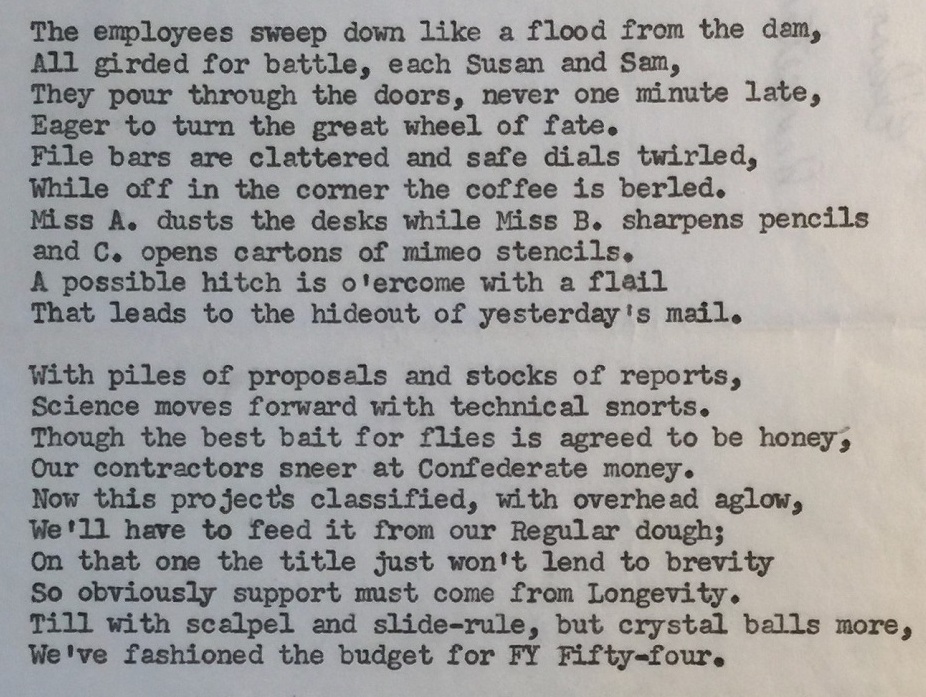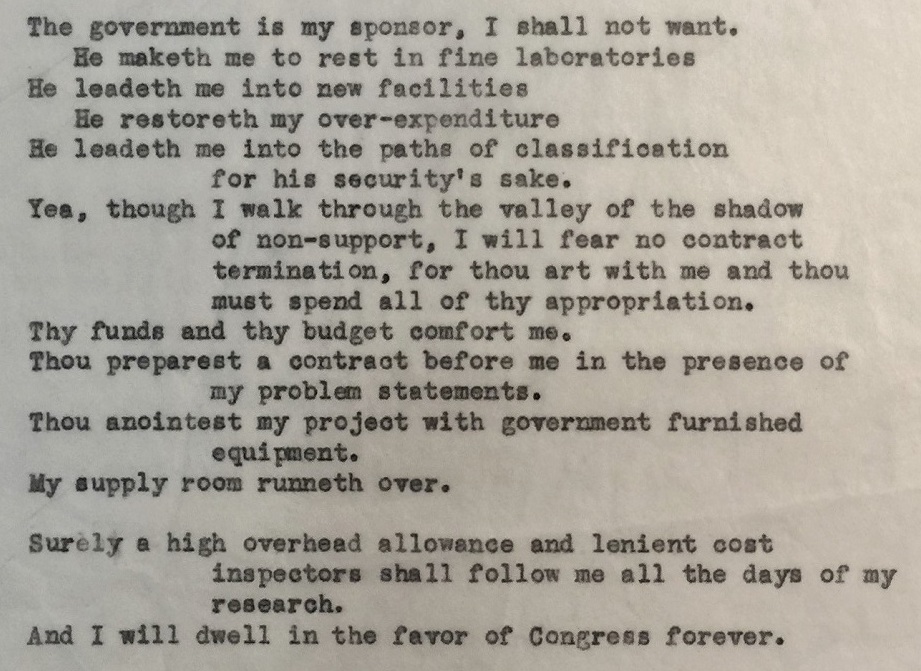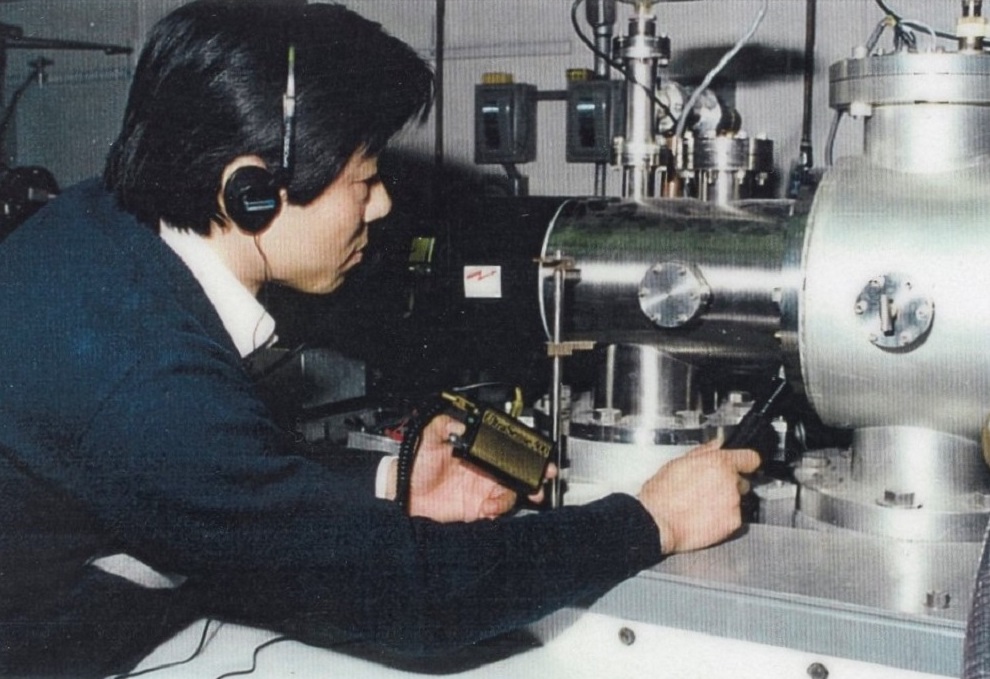The Price of Gold in a ‘Golden Age’
Two humorous poems illuminate the politics of science funding in the 1950s.

Two humorous poems illuminate the politics of science funding in the 1950s.

Poem included in the Papers of John B. Fenn, 1909–2010.
Among the least flashy things in a collection of fascinating but often unflashy things are two sheets of carbon paper, marked by a midcentury typewriter, unsigned. They illuminate a time some people remember as a golden age of science. A very specific group of people.
Typed on the sheets are two silly poems. One poem satirically celebrates the creation of a budget for fiscal year 1954. Heroes girded for battle sweep into an office like a flood. They make coffee, read reports, and flail for yesterday’s mail. Finally, “with scalpel and slide-rule, but crystal balls more,” they “fashioned the budget for FY Fifty-four.”
The other poem is a parody of Psalm 23. Instead of “The lord is my shepherd,” it begins, “The government is my sponsor, I shall not want.” The penitent scientist recites his gratitude for a government who “leadeth me into new facilities,” “restoreth my over-expenditure,” and who makes his “supply room runneth over.”

Poem included in the Papers of John B. Fenn, 1909–2010.
These poems live in the Institute’s archives in the “Humor” file of chemist and engineer John B. Fenn. We don’t know who wrote them, though they track with Fenn’s life.
Fenn crafted budgets in the mid-1950s as a research manager, directing money from the Office of Naval Research to attract scientists willing to study topics related to jet engines. And Fenn certainly had a whimsical sense of humor. His Nobel Prize lecture was titled “Electrospray Wings for Molecular Elephants,” alluding to the challenge of lofting comparatively heavy molecules into the measurement chamber of a mass spectrometer.

Elephants Have Wings, a cartoon by John Fenn’s daughter in honor of her father’s Nobel Prize lecture.
Fenn’s papers are held by the Institute because he won a share of the 2002 Nobel Prize in Chemistry for developing electrospray ionization, a technique for charging proteins so they could be analyzed using mass spectrometry.
The Institute’s museum displays the prototype electrospray ionization mass spectrometer that was developed in Fenn’s lab. It’s a strangely charismatic machine, Frankensteined together from parts of cast-off instruments. Looking at the taped-on operating instructions and hand-written labels around the switches, you can almost feel the presence of Masamichi Yamashita, the Japanese post-doc who built the instrument, and the sequence of graduate students who actually operated it.

Masamichi Yamashita uses a microphone to diagnose a problem with the vacuum system on the prototype electrospray ionization mass spectrometer he built as a member of John Fenn’s lab, from the Papers of John B. Fenn, 1909–2010.
But before Fenn oversaw the instrument’s development in the 1980s, he was a research administrator managing a U.S. Navy contract during the early days of the Cold War. The Navy wanted researchers who could solve problems related to jet engines, since it planned to develop submarine-launched cruise missiles out of the jet-propelled V-1 “buzz bombs” developed by Germany during World War II. But many academic scientists at the time frowned on doing sponsored research in applied science. As part of Project SQUID, the Office of Naval Research gave money to Princeton University to entice academic scientists to study jet propulsion by funding basic research in physics and chemistry. As a research administrator, Fenn awarded this money to university professors willing to study combustion, fluid dynamics, and heat transfer. In the early 1950s he had more money to spend than researchers to spend it on.
Scientists working on government contracts in the 1950s had little reason to be anxious about money. As the poem puts it, “Yea, though I walk through the valley of the shadow of non-support, I will fear no contract termination, for thou art with me and thou must spend thy appropriation.”
At the Science History Institute, we exhibit this poem in a display about Nobel Prizes, scientific labor, and biochemical instruments. That display also includes the automated peptide synthesizer, an instrument developed by Bruce Merrifield in the late 1950s for which he won the 1984 Nobel Prize in Chemistry.
In his autobiography, Life During a Golden Age of Peptide Chemistry, Merrifield wrote, “Some scientists have been more fortunate than they ever expected or even dreamed of, and I have been one of them.” Merrifield was a modest man, and he attributed much of his success to luck. Between grants from the federal government and the endowment of the Rockefeller Institute, Merrifield rarely had to worry about funding his lab.
However, there were sharp limits on who could benefit from a government that “anointest my project with government furnished equipment” and “preparest a contract before me in the presence of my problem statements,” as our unknown poet wrote. Anti-communism constrained the politics of scientists, both in public and private. The “Red Scare” was initially driven by Republican politicians seeking to break the electoral success the Democratic party had enjoyed during the Great Depression and World War II. Senator Joseph McCarthy first accused members of the State Department of harboring communist sympathies. But as science became more central to national security, and as debates about the atomic bomb and international control drew nuclear scientists into policy making, anti-communism transformed the politics of science. Scientific information relevant to national security was increasingly made secret and its distribution illegal. “He leadeth me into the paths of classification, for his security’s sake,” as the “Psalm” says. Consequently many scientists needed government permission (a “security clearance”) to work on particular projects or secure government contracts. These clearances could be revoked if one spoke out in the wrong ways politically, as Robert Oppenheimer learned.
The “Red Scare” was followed by the “Lavender Scare,” as congressional inquiries and government managers sought to find and fire gay and lesbian employees. Among the most consequential firings was Frank Kameny, an astronomer of the U.S. Army Map Service, who became a leading activist for gay rights over the next four decades. One of the government managers whose agencies carried out these discriminatory policies was James Webb, first at the State Department and later as the head of NASA.
Historical collections, including many of those held by the Institute, tend to preserve the accomplishments of people who benefited from government policies and funding. But we also must remember and seek out the stories of people whose exclusion was central to the creation of so-called “Golden Ages.”
The Science History Institute’s Othmer Library announces the winners of its 2025 After Hours comic book caption contest.
Collaboration, connection, and critique over pizza.
How to read a book when the pages are out of order.
Copy the above HTML to republish this content. We have formatted the material to follow our guidelines, which include our credit requirements. Please review our full list of guidelines for more information. By republishing this content, you agree to our republication requirements.